Copyright 2009-2024. All Rights Reserved.
Predecessor—The Birds of Hawaii and the Tropical Pacific (1987) has been in print for nearly four decades without a revision. First envisioned as a simple field guide, it has become the foundation for an explosion of ornithological research in the tropical Pacific. As a result of birder attention, 109 species new to the region and 18 species previously considered hypothetical have been added to the regional list. Field and genetic research have led to another 114 species added by taxonomic splits. As a result, the species list has doubled! Knowledge of bird distribution in the region has advanced significantly, especially with regard to seabirds, and a number of species have expanded their ranges or changed status, including at least twenty species thought to survive in 1985 (the cut-off date for the 1987 text) that have gone extinct. Obviously, a new book, in a modern format, is needed.
Authorship—One of Dr. Pratt's coauthors (Berrett) on the 1987 book is now deceased, and Phillip L. Bruner has withdrawn from the project, although some of the text will undoubtedly reflect some of his work from 1987. For the past several years Dr. Pratt has been assisted in writing the text by Dr. Eric VanderWerf, an expert ornithologist, birder, and conservationist with wide experience in the tropical Pacific. He brings a fresh look to the introductory chapters and will contribute heavily to the species accounts.
Plan of the new book—This book will be a modern-style guide with color pages on the right and accompanying text on facing pages (see examples below). It will be organized into four main sections: A (70 plates) Aquatic birds (seabirds, waterfowl, shorebirds, freshwater birds); H (23 plates) Land birds of the Hawaiian Islands; M (26 plates) Land birds of Micronesia; P (26 plates) Land birds of Polynesia including Fiji. Long-extinct and hypothetical species will be treated in two illustrated appendices. Species that may have gone extinct since the turn of the century will be included in the main text to increase awareness of the ongoing conservation crisis affecting island birds. With front matter, appendices, and literature cited, the book is expected to total around 330 pages. The text will incorporate and amplify that of the 1987 book with new information and, of course, many new species accounts. Still, a considerable amount of new text will be required for new information and additional species.
Illustrations—All species will be illustrated in color (plate outline available on request). Along with a large amount of completely new artwork, the plates will re-use many images from the 1987 book along with Pratt artwork from a variety of other sources. Thus, many of the plates will be constructed cut-and-paste, but some will be newly painted as a unit (see examples below). Much of the original artwork is available for sale as a way of supporting the project (see Art Gallery and Art Sales). Also, interested parties may sponsor artwork yet to be painted (ask about what may be available) by sending a 10% deposit, then the balance when the work is finished and can be delivered.
Current status of the project—As of November 2024, the book's illustrations are expected to include 1,815 full images and 176 half images (busts) or roughly 1,900 total individual images. Of these, approximately 65% are finished. The number of plates or images completed by section are Aquatics 16 of 70; Hawaii 16 of 23; Micronesia 21 of 26; Polynesia 18 of 26; Extinct 55 of 60 images; Hypothetical 10 of 14 images. Of course, the number of images per plate varies. Obviously, the land bird sections are much nearer completion than Section A, but importantly they include most of the endemic species. The authors and publisher are exploring ways to speed up completion of the book, but the only honest prediction for when it will be published is “ASAP.”
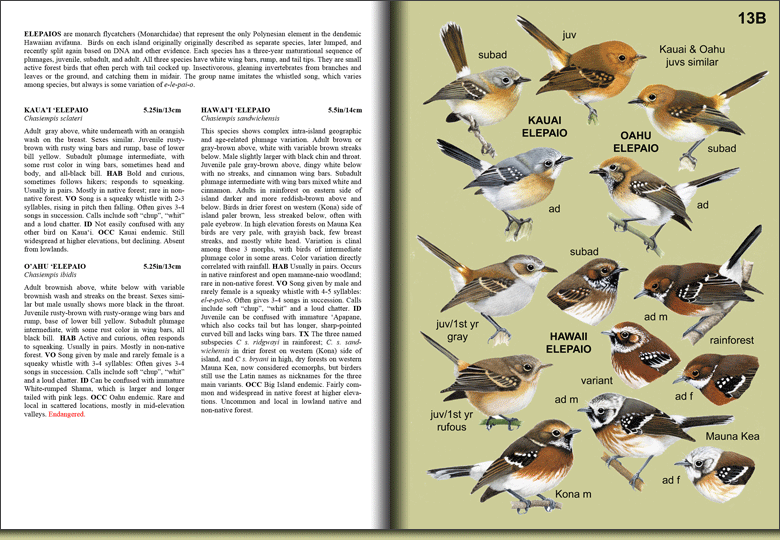
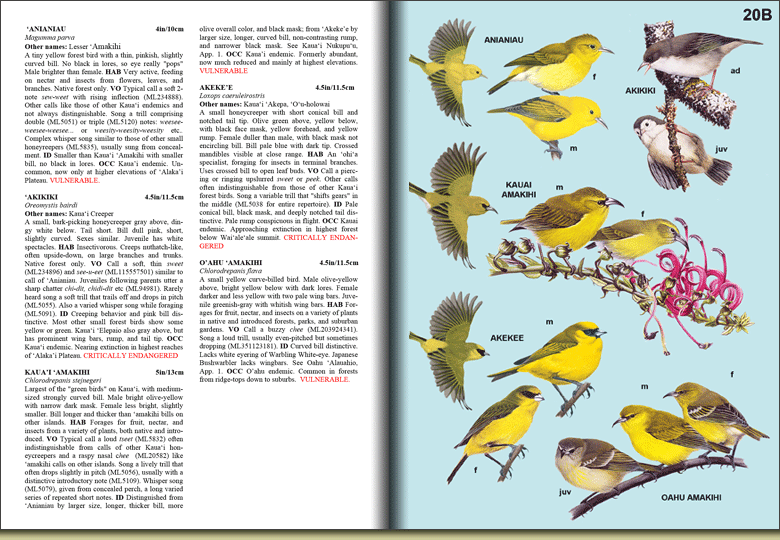
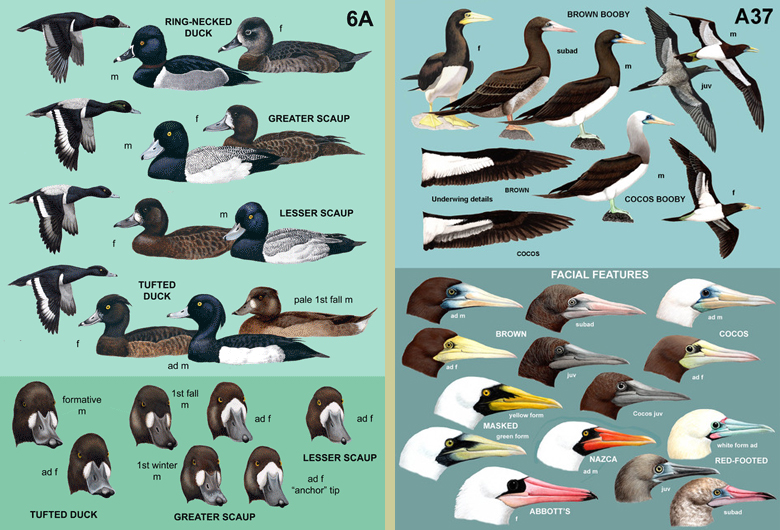
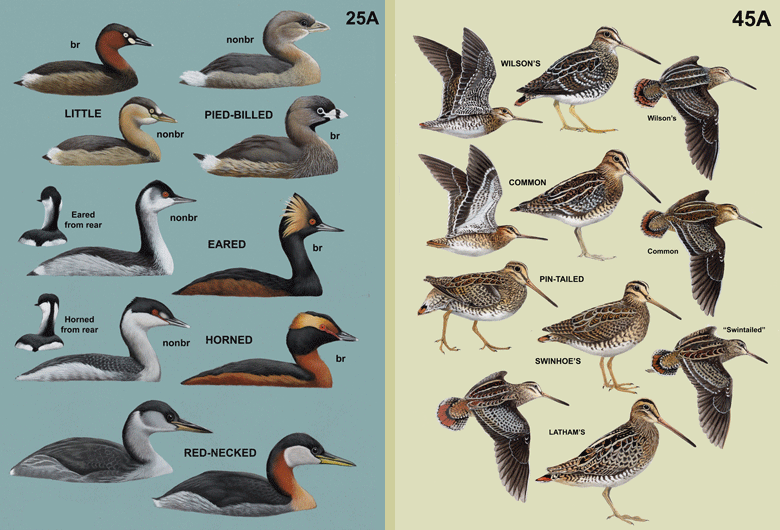
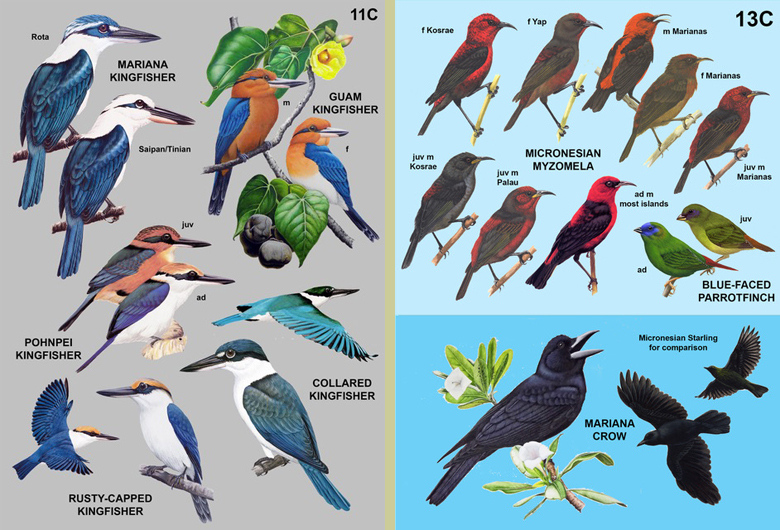
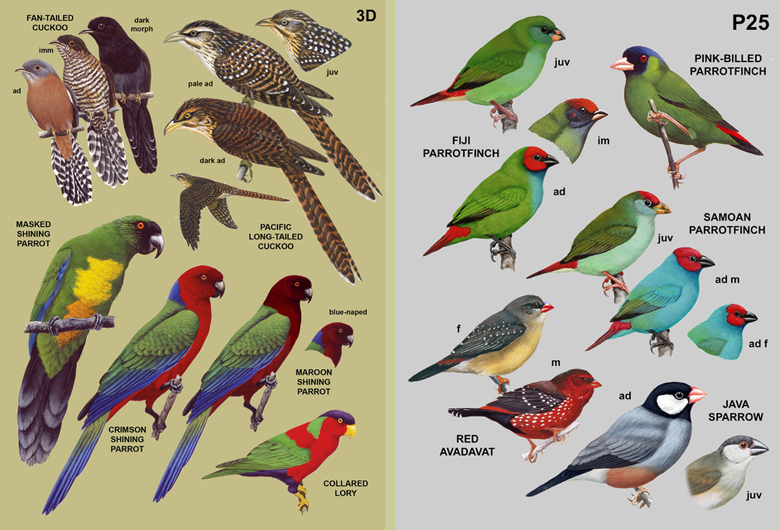
Authorship—One of Dr. Pratt's coauthors (Berrett) on the 1987 book is now deceased, and Phillip L. Bruner has withdrawn from the project, although some of the text will undoubtedly reflect some of his work from 1987. For the past several years Dr. Pratt has been assisted in writing the text by Dr. Eric VanderWerf, an expert ornithologist, birder, and conservationist with wide experience in the tropical Pacific. He brings a fresh look to the introductory chapters and will contribute heavily to the species accounts.
Plan of the new book—This book will be a modern-style guide with color pages on the right and accompanying text on facing pages (see examples below). It will be organized into four main sections: A (70 plates) Aquatic birds (seabirds, waterfowl, shorebirds, freshwater birds); H (23 plates) Land birds of the Hawaiian Islands; M (26 plates) Land birds of Micronesia; P (26 plates) Land birds of Polynesia including Fiji. Long-extinct and hypothetical species will be treated in two illustrated appendices. Species that may have gone extinct since the turn of the century will be included in the main text to increase awareness of the ongoing conservation crisis affecting island birds. With front matter, appendices, and literature cited, the book is expected to total around 330 pages. The text will incorporate and amplify that of the 1987 book with new information and, of course, many new species accounts. Still, a considerable amount of new text will be required for new information and additional species.
Illustrations—All species will be illustrated in color (plate outline available on request). Along with a large amount of completely new artwork, the plates will re-use many images from the 1987 book along with Pratt artwork from a variety of other sources. Thus, many of the plates will be constructed cut-and-paste, but some will be newly painted as a unit (see examples below). Much of the original artwork is available for sale as a way of supporting the project (see Art Gallery and Art Sales). Also, interested parties may sponsor artwork yet to be painted (ask about what may be available) by sending a 10% deposit, then the balance when the work is finished and can be delivered.
Current status of the project—As of November 2024, the book's illustrations are expected to include 1,815 full images and 176 half images (busts) or roughly 1,900 total individual images. Of these, approximately 65% are finished. The number of plates or images completed by section are Aquatics 16 of 70; Hawaii 16 of 23; Micronesia 21 of 26; Polynesia 18 of 26; Extinct 55 of 60 images; Hypothetical 10 of 14 images. Of course, the number of images per plate varies. Obviously, the land bird sections are much nearer completion than Section A, but importantly they include most of the endemic species. The authors and publisher are exploring ways to speed up completion of the book, but the only honest prediction for when it will be published is “ASAP.”






BIRDS OF THE TROPICAL PACIFIC: HAWAII, MICRONESIA, AND POLYNESIA
An updated successor to A FIELD GUIDE TO THE BIRDS OF HAWAII AND THE TROPICAL PACIFIC
An updated successor to A FIELD GUIDE TO THE BIRDS OF HAWAII AND THE TROPICAL PACIFIC


